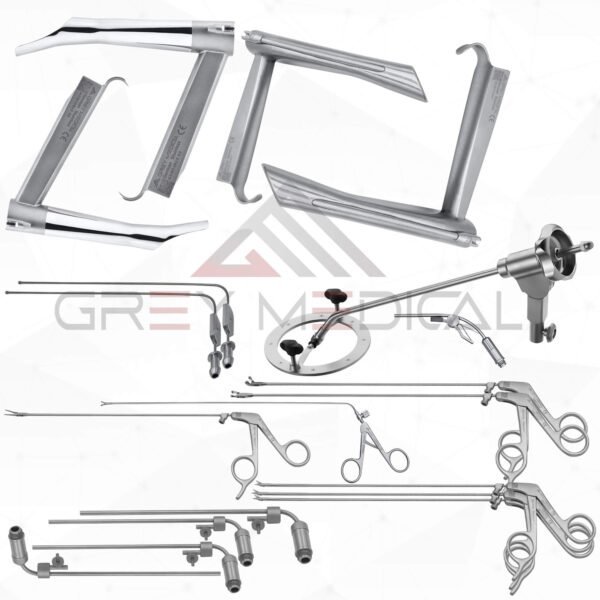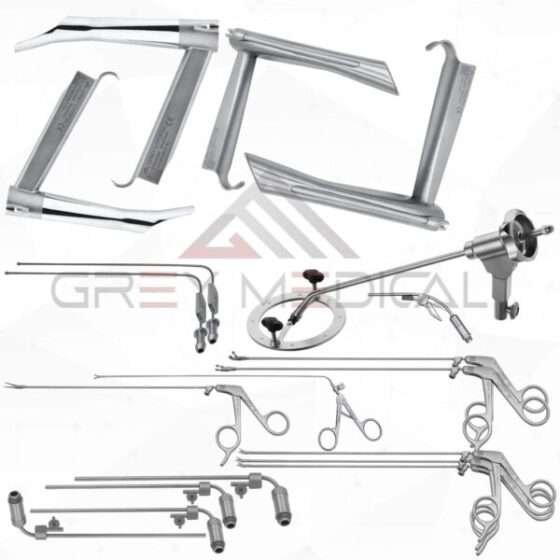Otolaryngology, commonly referred to as ENT (ear, nose, and throat) medicine, is a specialized field dedicated to diagnosing and treating conditions affecting these vital areas of the body. The precision and effectiveness of this medical branch heavily rely on the advanced instruments used by otolaryngologists. These tools not only enhance diagnostic accuracy but also ensure patient safety during complex surgical procedures.

What Are Otolaryngology Instruments?
Otolaryngology instruments are a collection of specialized tools designed for examining, diagnosing, and treating conditions related to the ear, nose, throat, head, and neck. These instruments cater to a wide range of procedures, from routine check-ups to intricate surgeries. Whether it’s a tool for visualizing the eardrum or an instrument to assist in delicate sinus surgeries, each device plays a crucial role in the field of otolaryngology.
These tools are engineered with precision, enabling otolaryngologists to access hard-to-reach areas with minimal discomfort to patients. Furthermore, technological advancements have continually improved these instruments, offering enhanced functionality and ease of use.
Key Categories of Otolaryngology Instruments
Otolaryngology instruments can be grouped into various categories, each serving distinct purposes. Diagnostic tools comprise equipment used in regular examinations to identify issues in the ear, nose, and throat. For example, otoscopes are fundamental in visualizing the inner ear, while endoscopes enable detailed exploration of nasal passages and sinuses.
Another category involves surgical instruments, which are designed to perform procedures with high precision. Instruments such as laryngoscopes for vocal cord inspection or microdebriders for sinus surgeries are exemplars of surgical innovation. These devices ensure accuracy and contribute to favorable patient outcomes.
Consumable tools and supplementary equipment, such as suction devices and forceps, also fall into this spectrum. Though often overlooked, these instruments are integral to maintaining a sterile and functional environment vital for patient care.
Advancements in Technology and Their Impact
Modern otolaryngology instruments have undergone remarkable transformations, thanks to advancements in technology. Innovations such as fiber optics and high-resolution imaging systems have revolutionized the way otolaryngologists approach diagnoses and treatments.
One notable innovation is the advent of video endoscopes, which provide enhanced visuals for both doctors and patients. These tools offer real-time, high-definition images, aiding in better communication and understanding of medical conditions. Additionally, the incorporation of robotic-assisted surgical tools has set a new standard in minimally invasive surgeries, reducing patient recovery times and improving surgical precision.
Another groundbreaking area is the use of laser technology in ENT procedures. Lasers are now used for tasks like removing polyps in the nasal cavity or treating vocal cord abnormalities with minimal tissue trauma. These advancements not only improve treatment outcomes but also make procedures safer and more efficient.
Why Are Otolaryngology Instruments Essential?
The importance of otolaryngology instruments cannot be overstated. These tools empower specialists to address a wide array of conditions ranging from ear infections and sinusitis to complex cancers of the head and neck. Their precision directly influences diagnostic accuracy, ultimately translating to better treatment plans and improved quality of care.
For example, an otoscope may help identify an eardrum infection during an early stage, preventing further complications. Similarly, advanced surgical instruments allow for meticulously targeted procedures, such as tumor excisions, while minimizing risks to surrounding tissues. They are indispensable not only in saving lives but also in enhancing the overall patient experience.
Challenges and the Path Forward
Despite their critical role, otolaryngology instruments face challenges, such as high costs and the need for continual training in their operation. Medical professionals often need to stay updated on the latest technologies to fully leverage the capabilities of modern tools. Additionally, the demand for reliable and durable instruments underscores the importance of collaborations between medical device manufacturers and healthcare institutions.
The future looks promising, however, as artificial intelligence (AI) and machine learning begin to integrate into otolaryngology. These technologies could be pivotal in enhancing diagnostic accuracy and predicting surgical outcomes, further complementing the tools in this field. Efforts aimed at democratizing access to advanced instruments through cost-effective innovations will also play a crucial role in global ENT healthcare improvement.
The Critical Role of Otolaryngology Instruments in Patient Care
Otolaryngology instruments serve as the backbone of this highly specialized medical field. From routine screenings to life-saving surgeries, these tools facilitate precise diagnosis and treatment of intricate conditions. With ongoing technological advancements, their capabilities continue to expand, offering new possibilities for improved patient care.
For otolaryngologists, the mastery of these instruments signifies not just technical proficiency, but also a commitment to delivering the highest standards of medical care. For patients, these tools offer the reassurance of receiving accurate treatments tailored to their needs. Together, they stand as a testament to how innovation in medical instruments can profoundly transform healthcare outcomes.
By understanding the significant role of otolaryngology instruments, we can appreciate how they enhance the field of ENT medicine and emphasize the need for ongoing advancements to further uplift patient care standards.









